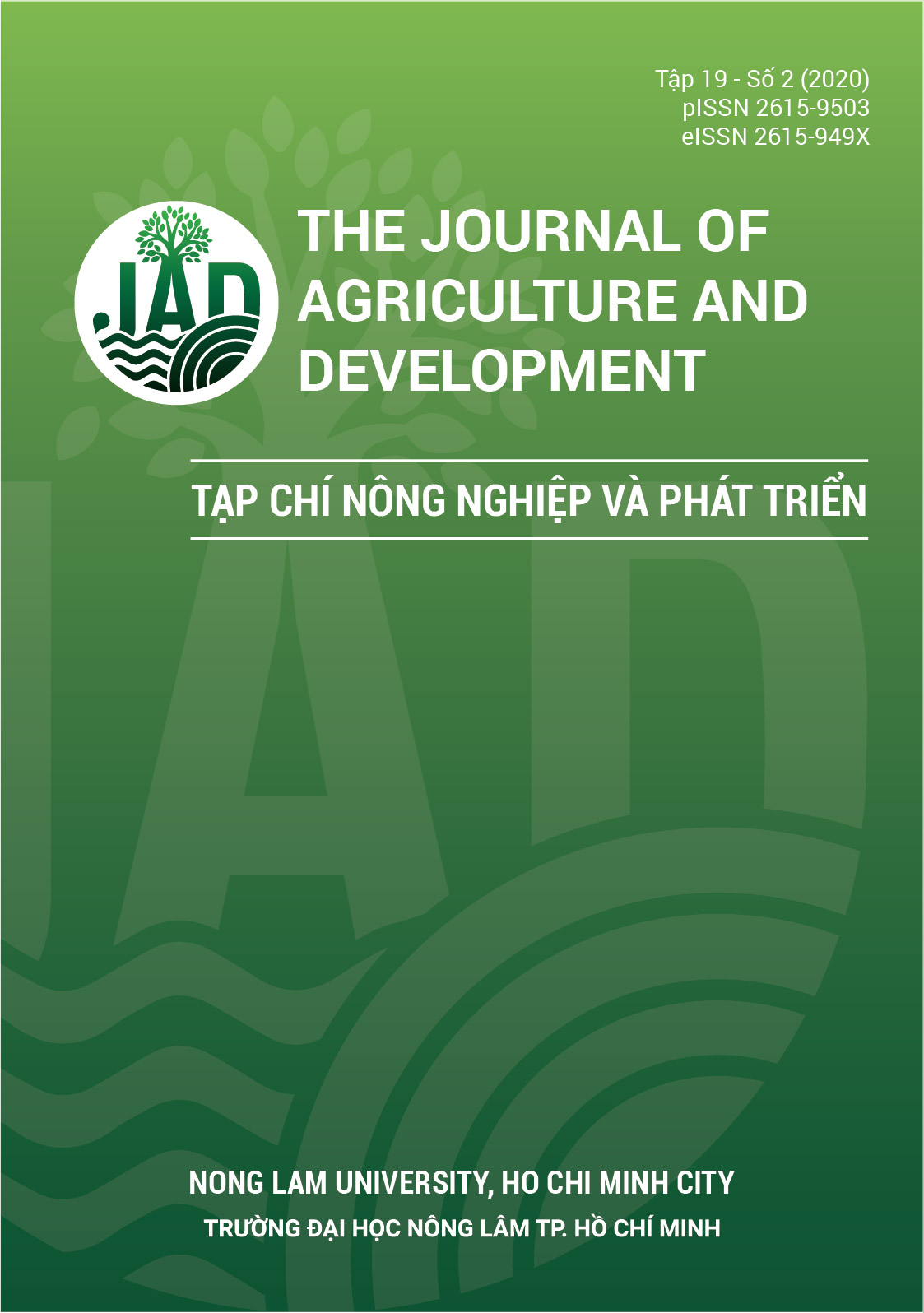Khả năng thay thế luân trùng bằng Artemia nauplius trong ương ấu trùng cá khoang cổ cam (Amphiprion percula Lacepede, 1802)
Main Article Content
Tóm tắt
Nghiên cứu được thực hiện nhằm rút ngắn thời gian sử dụng luân trùng trong ương ấu trùng cá khoang cổ cam giai đoạn mới nở đến 30 ngày tuổi. Artemia nauplius được sử dụng để thay thế luân trùng vào các thời điểm ấu trùng đạt 5, 7, 9, 11 và 13 ngày tuổi sau khi nở (NSN). Kết quả nghiên cứu cho thấy, ấu trùng bắt đầu được cho ăn Artemia nauplius từ ngày thứ 7 đạt tốc độ tăng trưởng đặc trưng về chiều dài cao nhất (4,02%/ngày). Thời điểm bắt đầu chuyển đổi thức ăn càng muộn, tốc độ tăng trưởng của ấu trùng càng giảm, thấp nhất tại thời điểm ngày thứ 13 sau khi nở (3,21%/ngày; P < 0,05). Tuy nhiên, không có sự khác biệt có ý nghĩa thống kê giữa các thời điểm chuyển đổi từ các ngày ương thứ 5, 9 và 11 (P > 0,05). Tương tự, thời điểm chuyển đổi thức ăn không ảnh hưởng tới tỷ lệ sống ấu trùng, dao động từ 39,6 - 48,2% (P > 0,05). Kết quả nghiên cứu này góp phần rút ngắn thời gian phụ thuộc vào luân trùng trong ương ấu trùng cá khoang cổ cam, giúp cải thiện hiệu quả sản xuất giống nhân tạo loài cá này.
Article Details
Tài liệu tham khảo
Allen, G. R. (1972). The anemonefishes: Their classification and biology (2nd ed.). New Jersey, America: T.F.H Publications.
Cortney, L. O, Eric, J. C., & Rhodes, A. (2016). Choosing an appropriate live feed for larviculture of marine fish. Florida, USA: UF IFAS Extension, University of Florida.
Cunha, I., & Planas, M. (1999). Optimal prey size for early turbot larvae (Scophthalamus maximus) based on mouth and ingested prey size. Aquaculture 175(1-2), 103-110. https://doi.org/10.1016/S0044-8486(99)00040-X
Dabrowski, K., & Bardega, R. (1984). Mouth size and predicted food size preferences of larvae of three cyprinid fish species. Aquaculture 40(1), 41-45. https://doi.org/10.1016/0044-8486(84)90214-X
Fernández-Diaz, C., Pascual, E., & Yúfera, M. (1994). Feeding behaviour and prey size selection of gilthead seabream, Sparus aurata, larvae fed on inert and live food. Marine Biology 118, 323-328. https://doi.org/10.1007/BF00349800
Gordon, A. K. (1999). The effect of diet and age-at weaning on growth and survival of clownfish Amphiprion percula Pisces: Pomacentridae (Unpublished master’s thesis). Rhodes University, Grahamstown, South Africa.
Green, B. S., & McCormick, M. I. (1999). Influence of larval feeding history on the body condition of Amphiprion melanopus. Journal of Fish Biology 55(6), 1273-1289. https://doi.org/10.1111/j.1095-8649.1999.tb02075.x
Hoff, F. H. (1996). Conditioning, spawning and rearing of fish with emphasis on marine clownfish. Florida, USA: Aquaculture Consultants Inc.
Houde, E. D., & Schekter, R. C. (1980). Feeding by marine fish larvae: developmental and functional responses. Environmental Biology of Fishes 5, 315-334. https://doi.org/10.1007/BF00005186
Hunter, J. P. (1981). Feeding ecology and predation of marine fish larvae. In Lasker, R. (Ed.). Marine fish larvae: Morphology, ecology, and relation to fisheries (33-77). Washington, USA: University of Washington Press.
Lavens, P., & Sorgeloos, P. (1999). Manual on the production and use of live food for aquaculture. Rome, Italy: FAO.
Léger, P., Bengtson D. A., Simpson K. L., & Sorgeloos P. (1986). The use and nutritional value of Artemia as a food source. Oceanography and Marine Biology And Annual Review 24, 521-623.
Lubzens, E., Tandler, A., & Minkoff, G. (1989). Rotifers as food in aquaculture. Hydrobiologia 186(1), 387-400. https://doi.org/10.1007/BF00048937
Moteki, M., Ishikawa, T., Teraoka, N., & Fushimi, H. (2001). Transition from endogenous to exogenous nutritional sources in larval sea bream. Pagrus major. Suisanzoshoku
Onal, U., Langdon, C., & Celik, I. (2008). Ontogeny of the digestive tract of larval percula clownfish, Amphiprion percula (Lacepede, 1802): a histological perspective. Aquaculture Research 39(10), 1077-1086. https://doi.org/10.1111/j.1365-2109.2008.01968.x
Shirota, A. (1970). Studies on the mouth size of fish larvae. Bulletin of the Japanese Society for the Science of Fish 36(4), 353-368. https://doi.org/10.2331/suisan.36.353
Stottrup, J. G., & McEvoy, L. A. (2003). Live feeds in marine aquaculture. Oxford, United Kingdom: Blackwell Scientific Publications Ltd. https://doi.org/10.1002/9780470995143
Tacon, A. G. J. (1988). The nutrition and feeding of farmed fish and shrimp - A training manual. 3. Feeding methods. FAO Field Document, Project GP/RLA/075/ITA Field Document No. 7, Brasilia, Brazil.
Wilkerson, J. D. (2001). Clownfishes: A guide to their captive care, breeding and natural history. New Jersey, USA: T. F. H Publications Inc.








